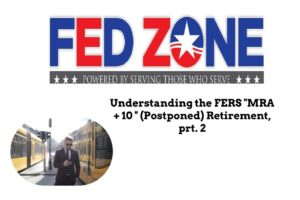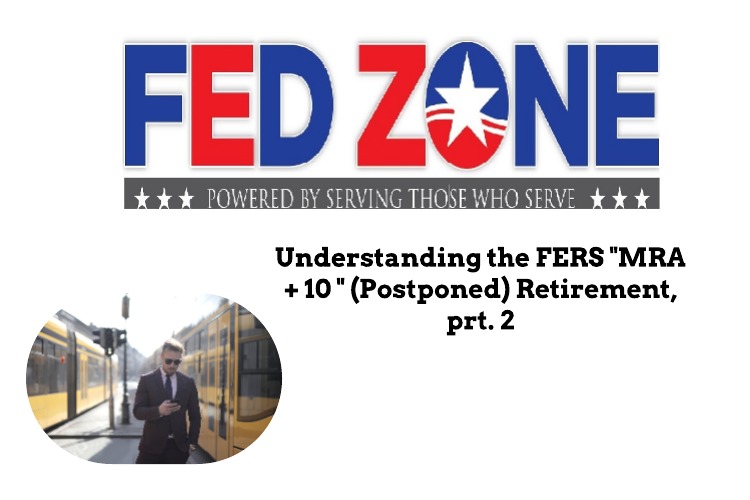Edward A. Zurndorfer
(for part I, click here)
Employees who are covered by the Federal Employees Retirement System (FERS) are eligible to retire optionally and, if certain requirements are met, will receive an immediate but reduced annuity under what is called an “MRA+10” (“postponed”) retirement. This is the second of two FEDZONE columns discussing “MRA+10” retirement available to many FERS employees. This column discusses why an employee would want to postpone the start of retirement benefits under “MRA+10” retirement. Also discussed are the procedures FERS employees have to follow in order to apply for an “MRA+10” retirement.
The first column on “MRA+10” retirement discussed who is eligible for this type of optional retirement available only for FERS employees. Among the items discussed in that first column were the calculations of the FERS annuity and the reduction of the annuity if a FERS retiree elects to start the annuity before age 62 or age 60, depending on how many years of federal service the FERS retiree had when he or she leaves federal service.
What was not discussed in the first column is that a FERS employee who fulfills certain prerequisites may keep throughout retirement the federal insurance benefits (health, life, dental/vision, and long-term care) that he or she had as an employee while in federal service. For federal employees, perhaps the most important insurance benefit is the Federal Employees Health Benefit (FEHB) program health insurance. A federal employee enrolled in the FEHB program pays an average 25 to 28 percent of the FEHB program health insurance premiums with the employee’s agency paying the other 72 to 75 percent of the FEHB premiums. The employee is eligible to keep the FEHB health insurance throughout retirement in which the federal government continues to pay 72 to 75 percent of the retiree’s FEHB program premiums. The requirement to keep this benefit is that the employee has to be a continuous participant in the FEHB program for at least the last five years of his or her federal service ending on the day of retirement.
Eliminating the Age Reduction Penalty by Postponing the Start of the FERS Annuity
A separating employee can reduce or even eliminate the age reduction penalty (equal to 5/12 of one percent for every month the departed employee is under age 62 (if the employee had between 10 and 19 years of service when leaving federal service) or is under age 60 (if the employee had between 20 and 29 years of service when leaving federal service) by postponing the commencing date of his or her FERS annuity. A separated and former employee who elects to postpone the FERS annuity (federal health and health insurance benefits will then be suspended until the FERS annuity starts) may elect to have the postponed annuity begin on any date later than the first day of any month following separation from federal service, subject to the following conditions:
- An election of a commencing date for the FERS annuity should be filed approximately 60 days before the designated commencing date and must be elected on Form RI-92-19 (Application for Deferred or Postponed Annuity).
- The former employee may not elect postpone the starting date of the FERS annuity that is earlier than the 31st day after the election is filed.
- A postponed annuity cannot begin later than the second day before the employee’s 62nd birthday.
- An election of a commencing date becomes irrevocable on the day OPM authorizes the first regular annuity payment.
An employee eligible for an immediate (but reduced) FERS annuity may decide to postpone the start of the annuity in order to decrease or avoid entirely the age percentage reduction as discussed in the first column. In that case:
- The departed employee’s group health insurance (FEHB) and group life insurance (FEGLI) coverages are temporarily suspended until it is reinstated when the postponed FERS annuity starts, effective the day after the employee’s final day of service;
- The departed employee will need to seek other health, dental/vision and life insurance while they are no longer enrolled in the FEHB and FEGLI programs, and the Federal Dental and Vision Insurance Program (FEDVIP). Note that the separated employee pays the full insurance premiums, with the federal government contributing nothing to the cost of the insurance. These policies are offered by private insurance companies or perhaps by an employer if the departed employee gets another job.
- The separated employee may elect temporary continuation coverage (TCC) of the FEHB program (maximum 18 months).
Once the departed employee elects to start receiving the postponed FERS annuity:
- The annuitant’s FEGLI may be reinstated based on the coverage he or she had at separation and was eligible to continue into retirement. The annuitant may elect reduced FEGLI coverage during the adjudication of the retirement application;
- The annuitant may reenroll in the FEHB program if he or she met the usual requirements for continuing coverage into retirement at separation. The annuitant may enroll in any FEHB program plan or option for which he or she is otherwise eligible.
- The annuitant may reenroll in the FEDVIP if he or she was enrolled in FEDVIP at the time of leaving federal service.
Survivor Benefits Under the MRA+10 Retirement
If an employee separates from service after having met the age and service requirements for an immediate MRA+10 annuity but dies before filing an application for retirement (Form RI 92-19), then he or she is deemed to have filed that application. The former employee is considered thereby insuring the rights of survivors to the following benefits:
- Annuity benefits to a surviving spouse (the survivor annuity is equal to 50 percent of what the annuitant would have received had he or she lived).
- Children benefits to surviving children.
- Eligibility of survivors for FEHB coverage if the deceased was eligible to continue coverage as an annuitant and had been enrolled in self plus one or self and family coverage.
- The lump-sum payment of FERS contribution to the person or persons entitled under the order of precedence.
Procedures for Employees at Separation for Immediate or Postponed MIRA+10 Retirement
1. An employee who wishes to apply for an immediate “MRA+10” retirement (that is, the FERS annuity check is to be received within one to 2 months after the employee leaves federal service) must complete at the time of separation and give to someone in the employee’s Human Resources or Personnel Office the following:
- Standard Form 3107 (Application for Retirement including Schedules A, B and C);
- Standard Form 3107-2 (Spouse’s Consent to Survivor Election) (if applicable); and
- Standard Form 2818 (Continuation of FEGLI Life Insurance Coverage), if applicable.
2. An employee who chooses not to file for an immediate “MRA+10” retirement at the time of separation and who elects to receive a postponed annuity (more than 30 days after the date of separation) does not file Form SF 3107. Instead, the departed employee should fill out and send to OPM a completed Form RI 92-19. Form 92-19 needs to be filed about 60 days before the date the separated employee wants the FERS annuity to begin. OPM’s address where the application is sent is on Form RI 92-19. The following example illustrates:
Susan leaves federal service at age 58 on May 8, 2020 with 22 years of FERS service. Susan becomes age 60 in January 2022. Susan should file Form RI 92-19 sometime in early November 2021. This is because Susan becomes age 60 in January 2022 and she wants her first (“postponed”) FERS annuity check dated Feb. 1, 2022.
Shortly after leaving or retiring from federal service, a FERS employee who is eligible for the “MRA+10” retirement will be paid for all unused annual leave hours. Any unused sick leave hours will be added to the departing employee’s service time for purpose of computing the FERS annuity.
With respect to any of the insurances that the employee was enrolled in at the time of departure (health insurance – FEHB, life insurance – FEGLI, dental/vision insurance – FEDVIP and long-term care insurance – FLTCIP), a departed employee is eligible to keep these insurances throughout retirement if certain conditions are met. For FEHB health insurance, the departed employee must have been a participant in the FEHB program, either through self only coverage or through a family member as part of self plus one or self and family coverage, for at least the last five years, ending on the day the employee left federal service. For FEGLI, the departed employee must have been enrolled in FEGLI for at least the five years ending on the day the employee left federal service. For dental/vision insurance, the departed employee must have been enrolled in the FEDVIP on the last day of federal service. For long-term care insurance, if the departed employee was enrolled in the FLTCIP on the day of departure from federal service, then coverage can continue even if the FERS annuity is postponed. However, the departed employee will have to make arrangements with LTCFEDS (www.ltcfeds.com) to have the FLTCIP premiums deducted from the departed employee’s personal checking or savings account.
An employee who leaves federal service under the “MRA+10” retirement is not eligible to receive at any time the FERS Retirement Annuity Supplement. This is the case whether the employee receives an immediate annuity or elects a postponed annuity.
The departed employee is eligible to start receiving his or her traditional TSP (without a 10 percent early withdrawal penalty) because the departed employee is over age 55. The departed employee can receive his or her traditional TSP without receiving a FERS annuity. With respect to the Roth TSP, in order to receive Roth TSP and not pay tax on the accrued earnings, the Roth TSP owner must be at least age 59.5 and it has to have been at least five years since January 1st of the first year the employee contributed to the Roth TSP.
Finally, departing employees under the “MRA+10” retirement are highly encouraged to make sure that all beneficiary forms are filled out and are current. These beneficiary forms include:
- TSP-3: TSP beneficiary form
- SF 2823: FEGLI beneficiary form
- SF 3102: Designation of Beneficiary of FERS contributions
- SF 2808: Designation of Beneficiary of CSRS contributions (this form is for FERS employees who will be receiving a CSRS annuity component to their retirement; this employee is called a “Trans”FERS)

Edward A. Zurndorfer is a CERTIFIED FINANCIAL PLANNER™ professional, Chartered Life Underwriter, Chartered Financial Consultant, Chartered Federal Employee Benefits Consultant, Certified Employees Benefits Specialist and IRS Enrolled Agent in Silver Spring, MD. Tax planning, Federal employee benefits, retirement and insurance consulting services offered through EZ Accounting and Financial Services, and EZ Federal Benefits Seminars, located at 833 Bromley Street – Suite A, Silver Spring, MD 20902-3019 and telephone number 301-681-1652. Raymond James is not affiliated with and does not endorse the opinions or services of Edward A. Zurndorfer or EZ Accounting and Financial Services. The information has been obtained from sources considered to be reliable, but we do not guarantee that the foregoing material is accurate or complete. While we are familiar with the tax provisions of the issues presented herein, as Financial Advisors of RJFS, we are not qualified to render advice on tax or legal matters. You should discuss tax or legal matters with the appropriate professional.
FERS MRA+10
